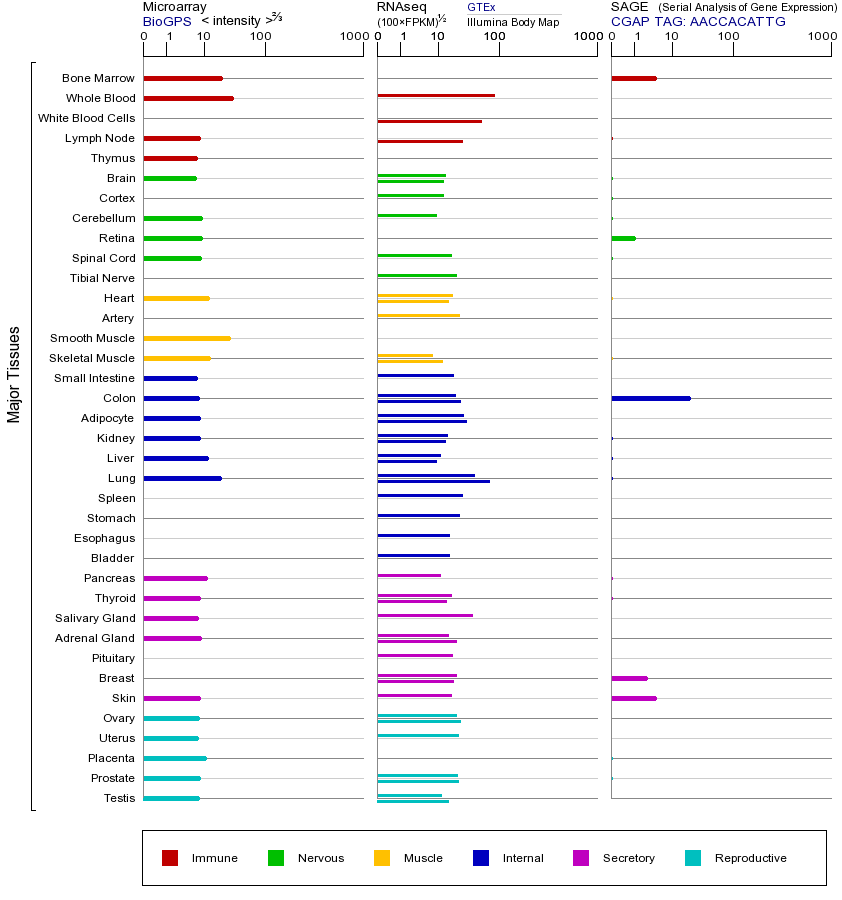PLAUR (plasminogen activator, urokinase receptor)
- symbol:
- PLAUR
- locus group:
- protein-coding gene
- location:
- 19q13
- gene_family:
- CD molecules
- alias symbol:
- URKR|UPAR|CD87
- alias name:
- urokinase-type plasminogen activat…
- entrez id:
- 5329
- ensembl gene id:
- ENSG00000011422
- ucsc gene id:
- uc002oxf.3
- refseq accession:
- NM_002659
- hgnc_id:
- HGNC:9053
- approved reserved:
- 1991-06-05
PLAUR(Plasminogen Activator, Urokinase Receptor)基因编码尿激酶型纤溶酶原激活物受体(uPAR),这是一种位于细胞膜上的糖蛋白受体,主要通过与尿激酶型纤溶酶原激活物(uPA)结合来调控纤溶酶原的激活过程。uPAR在细胞迁移、组织重塑、炎症反应和肿瘤转移等生理和病理过程中发挥关键作用。它通过激活纤溶酶原转化为纤溶酶,进而降解细胞外基质(ECM),促进细胞迁移和侵袭。此外,uPAR还能与其他分子如整合素和生长因子受体相互作用,调节细胞信号传导。PLAUR基因突变可能导致uPAR功能异常,影响纤溶系统平衡,与血栓形成、炎症性疾病和癌症转移等疾病密切相关。例如,uPAR过表达与多种恶性肿瘤(如乳腺癌、结肠癌和肺癌)的侵袭性和不良预后相关,因为它增强了肿瘤细胞的迁移和转移能力。相反,降低uPAR表达可能抑制肿瘤转移和炎症反应。PLAUR属于纤溶酶原激活物受体基因家族,该家族成员(如PLAUR和PLAUR2)均参与纤溶系统的调控,具有相似的糖基化结构和GPI锚定特性,通过与uPA结合激活下游通路。PLAUR的过表达还可能影响其他基因的功能,如上调基质金属蛋白酶(MMPs)的表达,进一步促进ECM降解;而低表达可能抑制这些效应。总之,PLAUR在多种生理和病理过程中起重要作用,其表达水平的异常与疾病发展密切相关。
This gene encodes the receptor for urokinase plasminogen activator and, given its role in localizing and promoting plasmin formation, likely influences many normal and pathological processes related to cell-surface plasminogen activation and localized degradation of the extracellular matrix. It binds both the proprotein and mature forms of urokinase plasminogen activator and permits the activation of the receptor-bound pro-enzyme by plasmin. The protein lacks transmembrane or cytoplasmic domains and may be anchored to the plasma membrane by a glycosyl-phosphatidylinositol (GPI) moiety following cleavage of the nascent polypeptide near its carboxy-terminus. However, a soluble protein is also produced in some cell types. Alternative splicing results in multiple transcript variants encoding different isoforms. The proprotein experiences several post-translational cleavage reactions that have not yet been fully defined. [provided by RefSeq, Jul 2008]
此基因编码尿激酶纤溶酶原激活剂受体和,鉴于其在定位和促进纤维蛋白溶酶的形成,有可能影响与细胞表面纤溶酶原激活和细胞外基质的局部降解许多正常和病理过程中的作用。它结合两个原蛋白和尿激酶纤溶酶原激活剂的成熟形式,并允许通过纤溶酶的受体结合亲酶的激活。该蛋白质缺少跨膜或细胞质结构域,并且可以被固定到由下面接近其羧基末端新生多肽的切割的糖基磷脂酰肌醇(GPI)部分质膜。然而,可溶性蛋白也在某些类型的细胞产生的。在多个转录剪接变异体导致编码不同亚型。原蛋白经历尚未被完全定义几个翻译后裂解反应。 [由RefSeq的,2008年7月提供]
基因本体信息
PLAUR基因(以及对应的蛋白质)的细胞分布位置:
- 质膜
- 细胞质
- 细胞外
- 高尔基体
- 囊泡
- 细胞骨架
- 内质网
- 细胞核
- 内体
- 溶酶体
- 线粒体
PLAUR基因的本体(GO)信息:
| 名称 |
|---|
| 4610 Complement and coagulation cascades [PATH:hsa04610] |
| 5205 Proteoglycans in cancer [PATH:hsa05205] |
| 名称 |
|---|
| Attachment of GPI anchor to uPAR |
| Dissolution of Fibrin Clot |
| Hemostasis |
| Metabolism of proteins |
| Post-translational modification: synthesis of GPI-anchored proteins |
| Post-translational protein modification |
| 疾病名称 | 关系值 | NofPmids | NofSnps | 来源 |
| Neoplasm Invasiveness | 0.2 | 2 | 0 | CTD_human_RGD |
| Neoplasm Metastasis | 0.134154703 | 17 | 0 | BeFree_CTD_human_LHGDN |
| Prostatic Neoplasms | 0.128173051 | 4 | 0 | CTD_human_LHGDN |
| Inflammation | 0.12272435 | 2 | 0 | CTD_human_LHGDN |
| Autistic Disorder | 0.12 | 2 | 0 | CTD_human |
| Peripheral Neuropathy | 0.12 | 1 | 0 | CTD_human |
| Juvenile arthritis | 0.12 | 1 | 0 | CTD_human |
| Myocardial Infarction | 0.085362824 | 3 | 0 | BeFree_GAD_LHGDN_RGD |
| Chronic Obstructive Airway Disease | 0.082367032 | 2 | 0 | GAD_RGD |
| Status Epilepticus | 0.08 | 1 | 0 | RGD |
联系方式
山东省济南市章丘区文博路2号 齐鲁师范学院 genelibs生信实验室
山东省济南市高新区舜华路750号大学科技园北区F座4单元2楼
电话: 0531-88819269
E-mail: product@genelibs.com
微信公众号
关注微信订阅号,实时查看信息,关注医学生物学动态。







